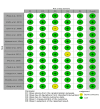Choices and Challenges With Drug Therapy in Postural Orthostatic Tachycardia Syndrome: A Systematic Review
- PMID: 37313107
- PMCID: PMC10259876
- DOI: 10.7759/cureus.38887
Choices and Challenges With Drug Therapy in Postural Orthostatic Tachycardia Syndrome: A Systematic Review
Abstract
The literature on pharmacologic treatments for postural orthostatic tachycardia syndrome (POTS) is inconsistent and unstandardized. Therefore, we aimed to evaluate choices in pharmacologic treatment options for POTS and the challenges encountered in the studies. We searched numerous databases like PubMed, Scopus, Embase, Web of Science, and Google Scholar for literature published before April 8, 2023. The search was done to retrieve potential peer-reviewed articles that explored drug therapy in POTS. Preferred Reporting Items for Systematic Review and Meta-Analysis (PRISMA) guidelines were used to conduct the systematic review. Of the 421 potential articles assessed, 17 met the inclusion criteria. Results demonstrated that pharmacologic treatment options for POTS were effective in reducing symptoms of POTS, but most of the studies were underpowered. Several were terminated due to various reasons. Midodrine ivabradine, bisoprolol, fludrocortisone, droxidopa, desmopressin, propranolol, modafinil, methylphenidate, and melatonin have been studied with positive impact but sample sizes that were low in the range of 10-50 subjects. Therefore, we concluded the treatment options effectively improve symptoms of POTS and increase orthostatic tolerance, but more evidence is needed as most studies had a low sample size and thus are underpowered.
Keywords: drug therapy; orthostatic intolerance; postural orthostatic tachycardia syndrome; pots-all types; treatment.
Copyright © 2023, Vasavada et al.
Conflict of interest statement
The authors have declared that no competing interests exist.
Figures



Similar articles
-
Oral medications for the treatment of postural orthostatic tachycardia syndrome; a systematic review of studies before and during the COVID-19 pandemic.Front Neurol. 2025 Jan 15;15:1515486. doi: 10.3389/fneur.2024.1515486. eCollection 2024. Front Neurol. 2025. PMID: 39882369 Free PMC article.
-
Management of Postural Orthostatic Tachycardia Syndrome in Pediatric Patients: A Clinical Review.J Pediatr Pharmacol Ther. 2024 Oct;29(5):456-467. doi: 10.5863/1551-6776-29.5.456. Epub 2024 Oct 14. J Pediatr Pharmacol Ther. 2024. PMID: 39411411 Free PMC article.
-
Treatment of Postural Orthostatic Tachycardia Syndrome With Medication: A Systematic Review.J Child Neurol. 2020 Dec;35(14):1004-1016. doi: 10.1177/0883073820948679. Epub 2020 Aug 24. J Child Neurol. 2020. PMID: 32838632
-
Postural tachycardia syndrome: a heterogeneous and multifactorial disorder.Mayo Clin Proc. 2012 Dec;87(12):1214-25. doi: 10.1016/j.mayocp.2012.08.013. Epub 2012 Nov 1. Mayo Clin Proc. 2012. PMID: 23122672 Free PMC article. Review.
-
Postural orthostatic tachycardia syndrome and other related dysautonomic disorders after SARS-CoV-2 infection and after COVID-19 messenger RNA vaccination.Front Neurol. 2023 Aug 16;14:1221518. doi: 10.3389/fneur.2023.1221518. eCollection 2023. Front Neurol. 2023. PMID: 37654428 Free PMC article. Review.
Cited by
-
Oral medications for the treatment of postural orthostatic tachycardia syndrome; a systematic review of studies before and during the COVID-19 pandemic.Front Neurol. 2025 Jan 15;15:1515486. doi: 10.3389/fneur.2024.1515486. eCollection 2024. Front Neurol. 2025. PMID: 39882369 Free PMC article.
-
Postural orthostatic tachycardia syndrome after COVID-19 vaccination: A systematic review.BMC Cardiovasc Disord. 2024 Nov 13;24(1):643. doi: 10.1186/s12872-024-04315-x. BMC Cardiovasc Disord. 2024. PMID: 39538129 Free PMC article.
-
A Case of Post-malarial Postural Orthostatic Tachycardia Syndrome in a Young Woman of South Asian Origin.Cureus. 2024 Oct 16;16(10):e71606. doi: 10.7759/cureus.71606. eCollection 2024 Oct. Cureus. 2024. PMID: 39552985 Free PMC article.
References
-
- Treatment of postural orthostatic tachycardia syndrome with medication: a systematic review. Hasan B, Almasri J, Marwa B, Klaas KM, Fischer PR. J Child Neurol. 2020;35:1004–1016. - PubMed
-
- The relationship between hypermobile Ehlers-Danlos syndrome (hEDS), postural orthostatic tachycardia syndrome (POTS), and mast cell activation syndrome (MCAS) Kohn A, Chang C. Clin Rev Allergy Immunol. 2020;58:273–297. - PubMed
Publication types
LinkOut - more resources
Full Text Sources
Miscellaneous
